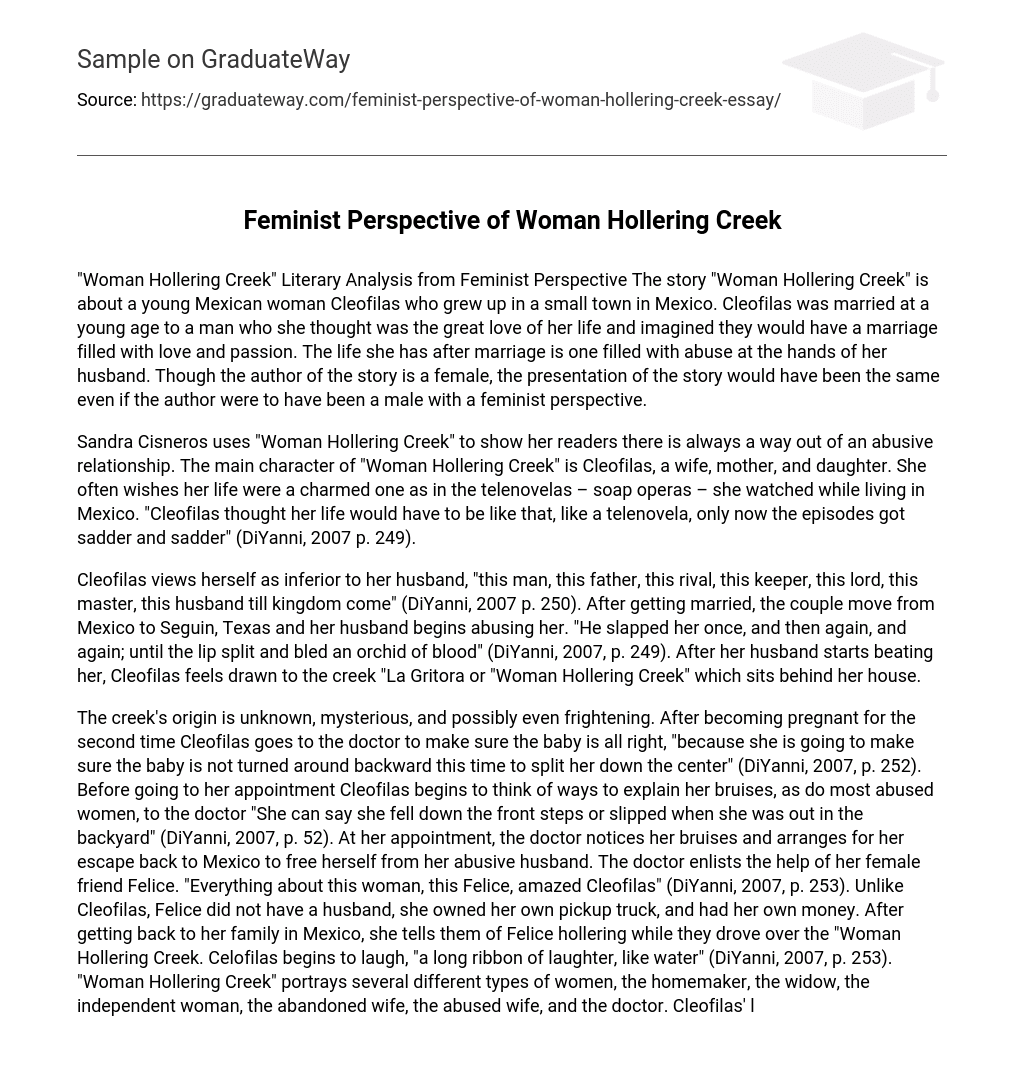“Woman Hollering Creek” Literary Analysis from Feminist Perspective The story “Woman Hollering Creek” is about a young Mexican woman Cleofilas who grew up in a small town in Mexico. Cleofilas was married at a young age to a man who she thought was the great love of her life and imagined they would have a marriage filled with love and passion. The life she has after marriage is one filled with abuse at the hands of her husband. Though the author of the story is a female, the presentation of the story would have been the same even if the author were to have been a male with a feminist perspective.
Sandra Cisneros uses “Woman Hollering Creek” to show her readers there is always a way out of an abusive relationship. The main character of “Woman Hollering Creek” is Cleofilas, a wife, mother, and daughter. She often wishes her life were a charmed one as in the telenovelas – soap operas – she watched while living in Mexico. “Cleofilas thought her life would have to be like that, like a telenovela, only now the episodes got sadder and sadder” (DiYanni, 2007 p. 249).
Cleofilas views herself as inferior to her husband, “this man, this father, this rival, this keeper, this lord, this master, this husband till kingdom come” (DiYanni, 2007 p. 250). After getting married, the couple move from Mexico to Seguin, Texas and her husband begins abusing her. “He slapped her once, and then again, and again; until the lip split and bled an orchid of blood” (DiYanni, 2007, p. 249). After her husband starts beating her, Cleofilas feels drawn to the creek “La Gritora or “Woman Hollering Creek” which sits behind her house.
The creek’s origin is unknown, mysterious, and possibly even frightening. After becoming pregnant for the second time Cleofilas goes to the doctor to make sure the baby is all right, “because she is going to make sure the baby is not turned around backward this time to split her down the center” (DiYanni, 2007, p. 252). Before going to her appointment Cleofilas begins to think of ways to explain her bruises, as do most abused women, to the doctor “She can say she fell down the front steps or slipped when she was out in the backyard” (DiYanni, 2007, p. 52). At her appointment, the doctor notices her bruises and arranges for her escape back to Mexico to free herself from her abusive husband. The doctor enlists the help of her female friend Felice. “Everything about this woman, this Felice, amazed Cleofilas” (DiYanni, 2007, p. 253). Unlike Cleofilas, Felice did not have a husband, she owned her own pickup truck, and had her own money. After getting back to her family in Mexico, she tells them of Felice hollering while they drove over the “Woman Hollering Creek. Celofilas begins to laugh, “a long ribbon of laughter, like water” (DiYanni, 2007, p. 253). “Woman Hollering Creek” portrays several different types of women, the homemaker, the widow, the independent woman, the abandoned wife, the abused wife, and the doctor. Cleofilas’ life experiences are very real; many women all over the world go through the same problems as Cleofilas. Cisneros uses the creek to symbolize the feelings that are a staple in an abusive relationship, not knowing how the abuse began or why it continues, and fear.
Another symbol is the laughter by Cleofilas at the end of the story. The laughter symbolizes freedom and the incredible feeling a person experiences when they finally attain freedom. As Cisneros shows in “Woman Hollering creek” victims can attain freedom by overcoming their fears, seek help, and leave as soon as an opportunity presents itself. References DiYanni, R. (2007). Woman Hollering Creek. Literature – Reading Fiction, Poetry, and Drama (6th ed. , 246-253). New York, NY: McGraw – Hill.





